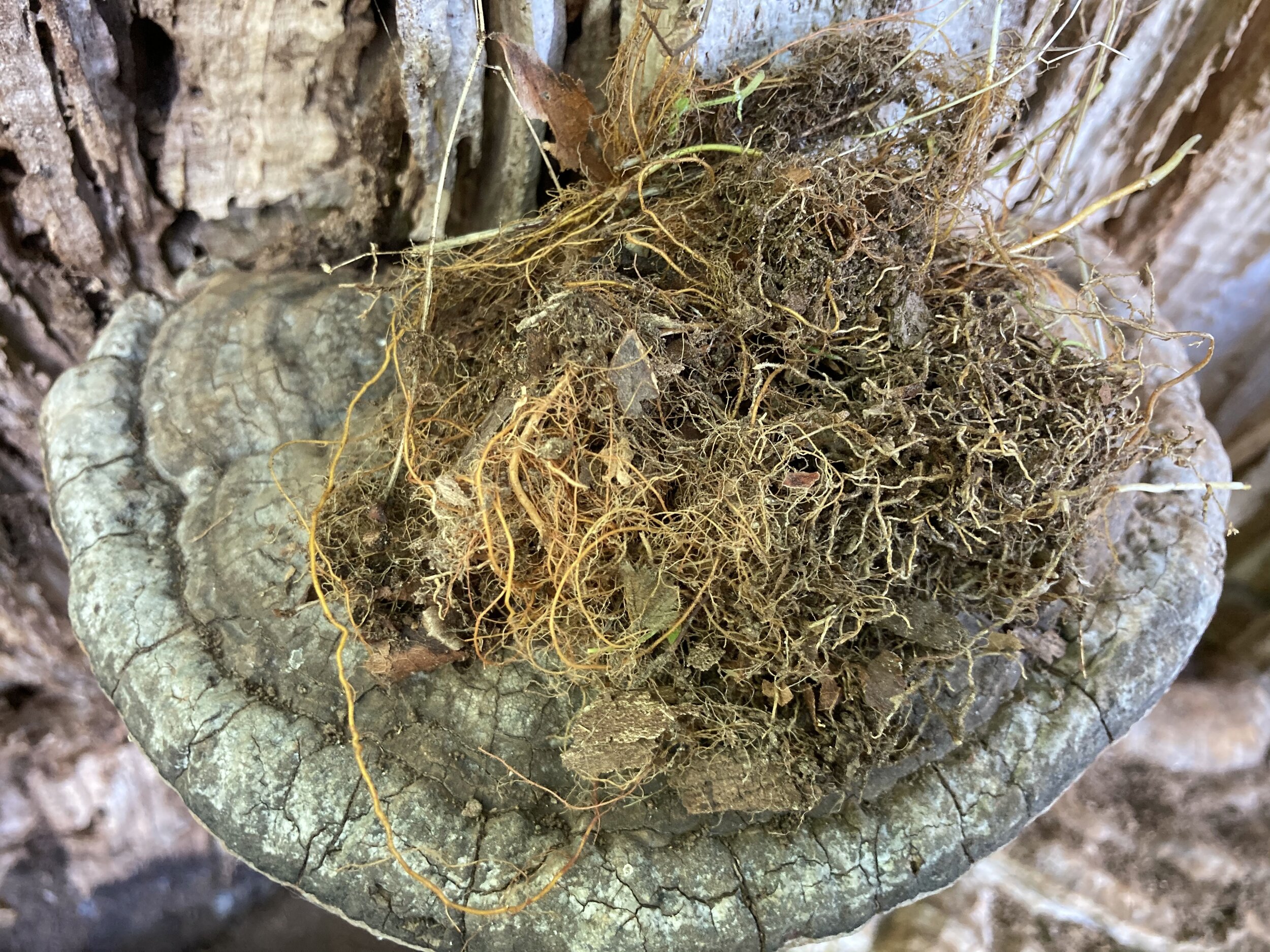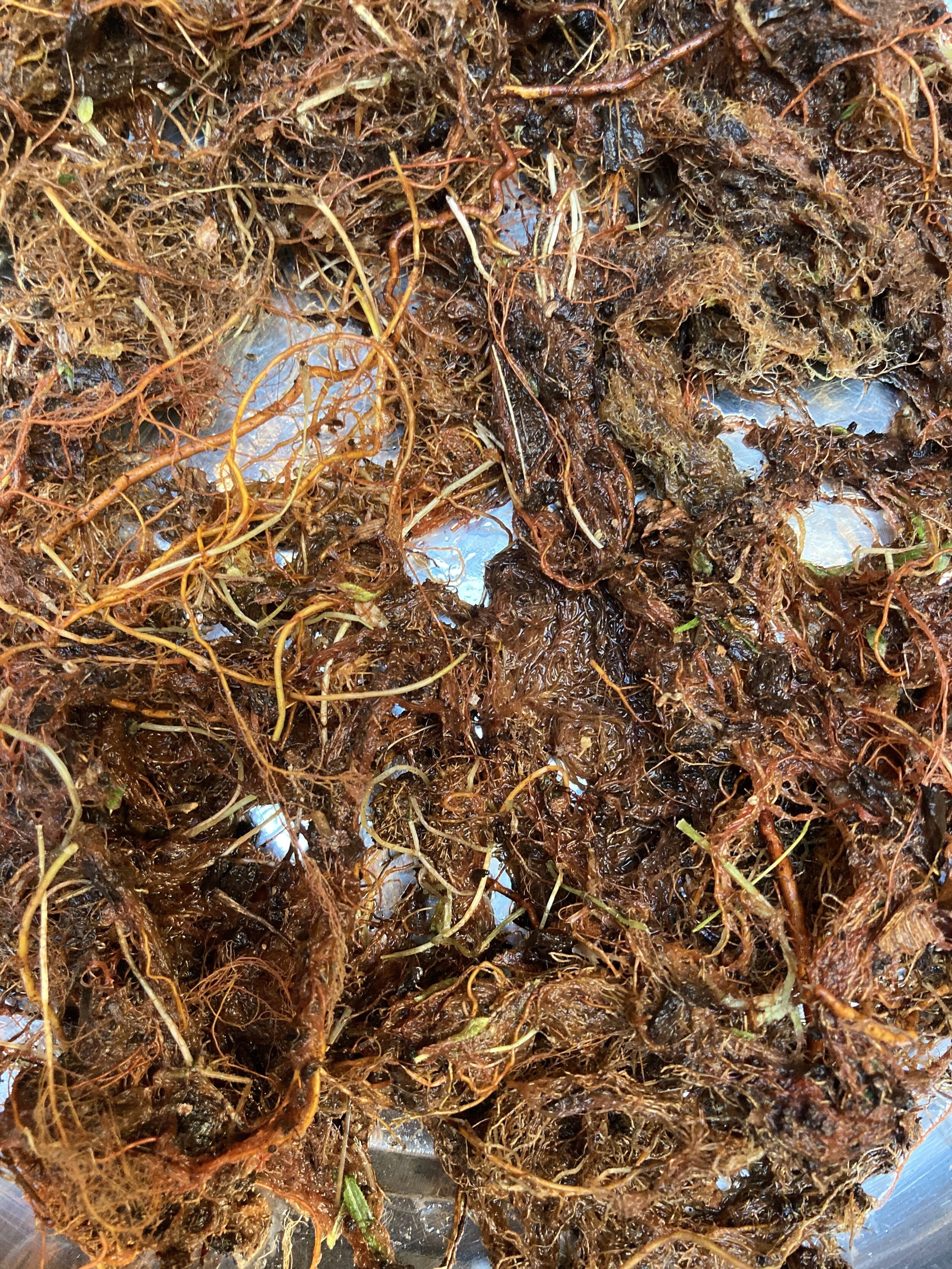Galium aparine: aka Common Bedstraw or Cleavers
I have been dyeing with cleaver’s beefier sibling madder (Rubia tinctorum) for probably 15 years. Madder and cleavers are in the same family (Rubiaceae) which produces a variety of red dyes with their roots. Our lesser-known local Galium species here in coastal British Columbia can give similar shades but is more challenging to harvest. Specifically, the roots of cleavers are both fine and delicate. Attempting to harvest the roots by pulling the plant out of the soil usually results in the plant snapping off at the base. Each small root mass must be excavated and as each plant provides a surprisingly small amount of roots (several times smaller than the plant itself), this must be done many times to yield enough roots for a dye project. To harvest cleavers, it’s best to locate (or grow) a patch growing in loose, sandy soil to make the root excavation easier. These specific roots were found around the base of a mature maple tree stump. The soil was ideal: loose and crumbly with decaying wood fiber. My method of collection was to follow each plant down the roots and use the roots themselves as a guide while I excavated around each root mass until they came away loosely. The extra fine root sections also held onto the soil fairly tightly, so I ended up collecting the roots and clumps of soil which I could then later wash out.
Cleavers
Is a taprooted annual common in gardens, roadsides, beaches and urban parks here in the Pacific Northwest. Once you recognize it, is seems to be growing everywhere. I located this patch within a small grove of trees which was due to be cleared. I decided to move ahead with harvesting as much as I could before the area could be made into a parking lot.
Like many of the colours I work with, the dyed yarn becomes one of the last reminders of a forest that isn’t with us anymore.
Whole plant
The above ground portion of cleavers is significantly larger than the roots as in the photo on the left. Here you can see multiple stems coming from a single taproot.
Closeup: roots
This was the stage of the harvest where I began to wonder if I wasn’t completely wasting my time. The roots are a pale yellow when they first emerge, nothing about them reminded me of working with madder yet.
Fruits of the harvest
This tidy little pile of roots is about half an hour of work. They are still tangled up with a significant amounts of vegetation matter, soil and rocks that will have to be removed at home.
Rinsing
Once home, I started to rinse the roots in small batches, picking out any extra materials. I kept at it until I saw the water the roots were soaking in begin to take on a reddish hue and I was concerned I was losing some of the dye potential. Looking over the roots, I estimated about 20% of the weight of the roots was still this extraneous material so I added that into my calculations for weighing the roots below.
Drying the roots
Once the roots started to dry, they began to take on more of a red hue which definitely helped me feel less like I was wasting my life collecting living sewing thread from dirt. Maybe life has meaning after all.
Chop chop
Once dry, I chopped up the roots quite finely in a small metal bowl using scissors. The root mass weighs about 17.9 grams (145.7 g - 127.8 g for the bowl = 17.9 g). I also estimated above that about 20% of this weight is excess matter that remained with the roots (80%) which has no dye value, for a total of 14.3 g of roots (17.9g x0.80 = 14.3g).
Roots = 14.3 g.
Wool skein = 5.9 g.
Weight of Fiber is 242% WOF, or aka I used approximately 2.4 times more roots than wool.
Dye vat
The cleavers was added to a 2-liter glass jar with water. The excess soil and vegetable matter started to drop down as the roots stayed floating. Still very little indication of the dye potential here before heat was added.
Simmering
The jar was heated to a simmer for an hour in a double boiler set up. The liquid slowly began to turn a deep orange.
Adding the wool
The wool skein had been previously mordanted with an alum solution at 16% WOF for an hour simmer before being dried and stored. While the roots were simmered, this wool was soaked for an hour in warm water and added to a 1-gallon mesh paint bag. These bags are so great for keeping the fiber and dye material apart.
Quick colour
Within 10 minutes, the wool began to take a surprisingly rich coral red. Unlike madder which makes a dark orange with our (6.5 pH) tap water, instead cleavers has clear tones within the pink-red spectrum.
Experimenting
Knowing that boosting the pH deepens the red shades of madder, I was curious what would happen if I did something similar with cleavers. I took out most of the wool, and left a small amount in the dye vat. I then added 1/4 tsp of washing soda which boosted the pH to 11 (from 6.5) and left it to soak for 5 mins.
Results left to right:
Skein 1 (small): Premordant of alum (16%), G. aparine (242% WOF), pH of 11. Colour: dark coral.
Skein 2 (big): Premordant of alum (16%), G. aparine (242% WOF), pH of 6.5. Colour: coral/pinky red.
Take Away
The results were a fun surprise and I’ve already started collecting more for future dyeing. I wonder what yarn dyed with 500% WOF might look like? Ultimately, I feel the extra effort to forage and process the cleavers was worth totally it.















